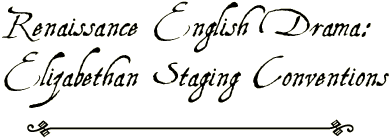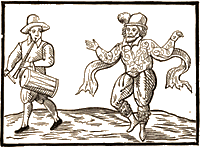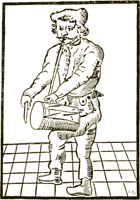|
|
|
|

By Dr. Wayne Narey, Arkansas State University

In the private theatres, act-intervals and music between acts were customary from the beginning. A music-room was at first lacking in the public playhouses, since public-theatre performances did not originally employ act-intervals and inter-act music. About 1609, however, after the King's men had begun performing at the Blackfriars as well as at the Globe, the custom of inter-act music seems to have spread from the private to the public playhouses, and with it apparently came the custom of using one of the tiring-house boxes over the stage as a music-room.
The drama was conventional, not realistic: poetry was the most obvious convention, others included asides, soliloquies, boys playing the roles of women, battles (with only a few participants), the daylight convention (many scenes are set at night, though the plays took place in mid-afternoon under the sky), a convention of time (the clock and calendar are used only at the dramatist's discretion), the convention of "eavesdropping" (many characters overhear others, which the audience is privy to but the overheard characters are not), and movement from place to place as suggested by the script and the audience's imagination. Exits were strong, and when everyone departed the stage, a change of scene was indicated. There was relatively little scenery. Scenery was mostly suggestive; for example, one or two trees standing in for a whole forest. The elaborate costumes—for which companies paid a great deal of money—supplied the color and pageantry. Minimal scenery and limited costume changes made the transitions between scenes lightning-fast and kept the story moving.
 There was often dancing before and after the play—at times, during, like the peasants' dance in Shakespeare's Winter's Tale. Jigs were often given at the end of performances, a custom preserved still today at Shakespeare's Globe. The jigs at the theatre were not always mere dances, they were sometimes comprised of songs and bawdy knockabout farces filled with commentaries on current events. Perhaps the most famous jig was the one performed by Will Kemp, the clown in Shakespeare's company, over a nine day period in 1599, on the road from London to Norwich. It was published in 1600 as Kemps nine daies wonder. After 1600, the bawdy jigs fell into derision and contempt and were only performed at theatres such as the Red Bull, which catered to an audience appreciative of the lowest humor and most violent action. There was often dancing before and after the play—at times, during, like the peasants' dance in Shakespeare's Winter's Tale. Jigs were often given at the end of performances, a custom preserved still today at Shakespeare's Globe. The jigs at the theatre were not always mere dances, they were sometimes comprised of songs and bawdy knockabout farces filled with commentaries on current events. Perhaps the most famous jig was the one performed by Will Kemp, the clown in Shakespeare's company, over a nine day period in 1599, on the road from London to Norwich. It was published in 1600 as Kemps nine daies wonder. After 1600, the bawdy jigs fell into derision and contempt and were only performed at theatres such as the Red Bull, which catered to an audience appreciative of the lowest humor and most violent action.
 The clowns were the great headliners of the Elizabethan stage prior to the rise of the famed tragedians of the late 1580s, such as Edward (Ned) Alleyn and Richard Burbage. Every company had a top clown along with the tragedian—Shakespeare’s company was no exception: Richard Tarleton was the clown until his death in 1588, Will Kemp was the clown until forced out of the company in 1599, to be replaced by another famous clown, Robin Armin. The clowns not only performed the aforementioned jigs, but also played many of the great comic characters; Kemp most likely played Peter in Romeo and Juliet and Dogberry in Much Ado About Nothing, Armin the parts of Feste in Twelfth Night and the Fool in King Lear. The clowns were the great headliners of the Elizabethan stage prior to the rise of the famed tragedians of the late 1580s, such as Edward (Ned) Alleyn and Richard Burbage. Every company had a top clown along with the tragedian—Shakespeare’s company was no exception: Richard Tarleton was the clown until his death in 1588, Will Kemp was the clown until forced out of the company in 1599, to be replaced by another famous clown, Robin Armin. The clowns not only performed the aforementioned jigs, but also played many of the great comic characters; Kemp most likely played Peter in Romeo and Juliet and Dogberry in Much Ado About Nothing, Armin the parts of Feste in Twelfth Night and the Fool in King Lear.
From contemporary documents, we know there were over a thousand actors in England between 1580-1642*. Most were poor, "starving actors", but a few dozen were able to make names for themselves and become shareholders in their respective companies, and make a good living. The repertory system was demanding—besides playing six days a week, a company would be in continual rehearsal in order to add new plays and to refresh old ones in their schedule. A player would probably learn a new role every week, with thirty to forty roles in his head. No minor feat, especially considering that an actor would only get his lines and cues (in a rolled up parchment, his "roll", from which we get the word "role"), not a whole script! Over a period of three years, a tragedian such as Edward Alleyn, lead player for the Admiral's Men, would learn not only fifty new parts but also retain twenty or more old roles.
* Michael Best, Internet Shakespeare Editions.

To cite this article:
Narey, Wayne. "Elizabethan Staging Conventions." Luminarium.
2 Aug 2006. [Date you accessed this article].
<http://www.luminarium.org/renlit/dramastaging.htm>

Continue to:
English Drama: From Medieval to Renaissance
The Sociopolitical Climate
in Elizabethan England
Elizabethan World View
Elizabethan Playhouses
Elizabethan Staging
Conventions
Timeline of Elizabethan Playhouses and Acting Companies
 | to Renaissance Drama
|
 | to Renaissance Literature
|
Site copyright ©1996-2010 Anniina Jokinen. All rights reserved.
This page created by Anniina Jokinen on August 2, 2006. Last updated August 16, 2010.
|
|
|